Is your dog slipping on the floor? If so, help is here! Integrative veterinarian Dr. Julie Buzby—whose passion for finding solutions for slipping dogs led to the development of her signature product, Dr. Buzby’s ToeGrips® dog nail grips—shares 15 tips to stop your dog from slipping on the floor.
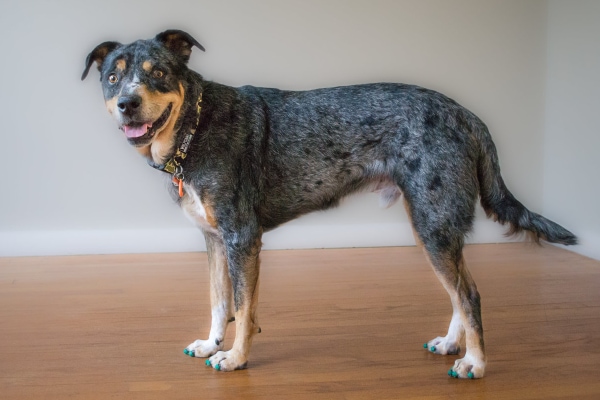
As the parent of a senior dog, tripawd dog, or really any dog who slips on hardwood floors, you know how heartbreaking it is to see your best friend struggling.
I get it. I’ve talked to a lot of dog parents whose dogs are in the grey-muzzle club. One common thread that runs through those conversations is that senior dog parents are tired of watching their dogs slip on the floor multiple times a day. They are worried about their dogs and want a solution to “stop the slip.”
To help address these concerns, I decided to make a list of my top 15 tricks to keep your dog from slipping on the floor. I’m confident the tips and tricks in this article can help improve your slipping dog’s quality of life—and yours too.
Why do dogs slip on the floor?
But first things first. Before we talk about HOW to fix the problem of slipping on the floor, we first need to discuss WHY dogs slip on hard floors.
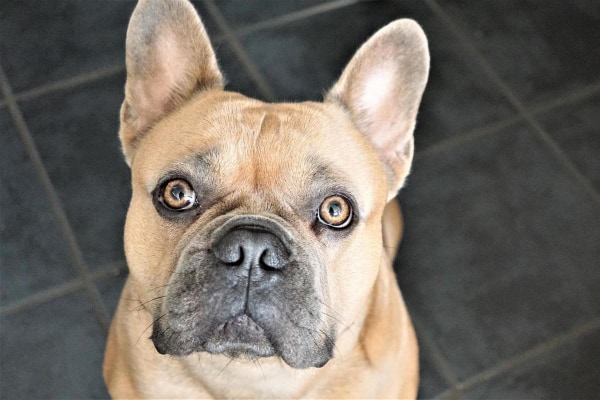
Have you ever painstakingly picked your way across an icy driveway? Or slipped and slid across a freshly-cleaned hardwood floor in your socks (accidently or on purpose)? If so, you may have an idea of what a dog experiences when he or she walks on a smooth surface like wood or tile floors.
To keep from slipping, dogs attempt to use their toenails for traction. They flex their toes and dig the nails into the ground, just like soccer cleats. This works great on surfaces like grass, dirt, or carpet that have a bit of give to them. However, on hard smooth surfaces, dogs can’t dig their toenails into anything. Therefore, the dog has less traction and is more likely to slip.
Additionally, dogs who have an abnormal gait or weaker muscles are at increased risk for falling on slippery surfaces like tile, laminate, and hardwood floors. This is because dogs with these problems usually do not have the strength and muscle development to ensure that their feet and nails are making proper contact with the floor. Conditions that may make slipping more common for dogs include:
- Age (older dogs)
- Osteoarthritis in dogs
- Dog leg amputation (dogs with three legs)
- Torn ACL in dogs
- Paralysis
- IVDD in dogs
- Hip dysplasia in dogs
- Dogs with back legs collapsing (i.e. hind end weakness)
- Strained iliopsoas (i.e. groin muscles)
- Recovering/rehabilitating from surgery
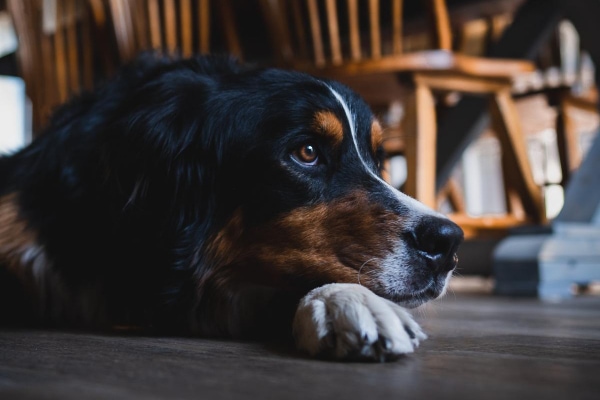
What’s so bad about a dog slipping on the floor?
In addition to the conditions on the list above that make a dog more likely to slip, they also make the dog more prone to further injuries. So, we definitely don’t want these weak or already injured dogs slipping! Realistically though, we really don’t want any dog slipping on floors.
Every time a dog slips or falls, he or she is at risk for becoming physically injured. Also, every time a dog loses traction, he or she may be emotionally injured, too.
As dogs lose confidence after falling multiple times, they can become afraid of certain areas of the house or certain types of floors. If a dog is afraid of hardwood floors, he or she may stop moving to be closer to their family. This can result in decreased quality of life for the dog due to higher stress levels and loneliness.
And of course, every time you watch your dog fall, it concerns you as well. It is difficult to watch your dog slipping without knowing how to help him or her navigate your tile or hardwood floors.
So, now that we have an overview of why it’s critical to stop your dog’s slipping, let’s discover 15 tips to help your beloved dog.
15 tips to stop your dog from slipping
#1. Visit your veterinarian first
Any time you notice a change in your dog that affects his or her health or safety, you should schedule an appointment with your veterinarian to discuss your observations. This includes if your dog begins slipping and falling.
Dogs can slip and fall for many different reasons, and the list I shared above only captured some of the more common ones. Maybe your dog is suddenly weak from a spinal cord issue. Or he or she recently injured a joint, tendon, ligament, or muscle. Perhaps your furry friend is starting to show signs of arthritis in dogs. Or it could be something else entirely.
The plan for each of these scenarios may look a bit different. That’s why knowing the reason your dog is slipping and sliding is so important.
Your veterinarian can help you determine the cause of the slipping. He or she will typically begin by talking to you about your dog’s history then performing a physical exam to look for any changes or signs of an injury. Sometimes, your vet may recommend X-rays or other diagnostics as well to further evaluate the joints or follow up on any abnormalities on the exam.
Based on what he or she finds, your veterinarian can help you develop a strategic plan for your dog that is based on your dog’s specific needs. Some of the things I discuss next may be part of that plan.
#2: Apply ToeGrips, the #1 solution for slipping dogs
Without a doubt, Dr. Buzby’s ToeGrips® dog nail grips are my favorite practical solution for slipping dogs. If I didn’t think that visiting the veterinarian was so important, I would have put ToeGrips as #1 on this list. And I probably would put ToeGrips down as #2 through 100 as well. That’s how much I believe in their power to transform dog’s lives.
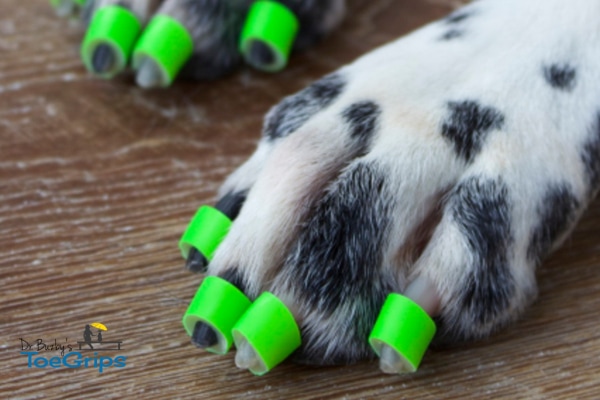
ToeGrips are non-slip rubber grips that fit onto a dog’s toenails to give instant traction on hard-surface floors and stairs. They provide traction that travels everywhere your dog goes. Once placed on the toenails, ToeGrips are made for indoor/outdoor use, can be worn constantly, and typically need to be replaced every one to three months.
Unlike dog socks and boots, which interfere with a dog’s paw and toenails (i.e. a dog’s natural gripping mechanisms), ToeGrips® create a GripZone™ between the nails and floor that works with your dog’s innate biomechanics. The GripZone™ allows the toenails to meet the floor for traction with every step…naturally.
One of my favorite things is watching the transformation in a dog after ToeGrips are applied. You can see the results in a dog’s gait almost immediately. And over time, as the dog isn’t slipping as much, his or her confidence will increase. The end result is improved quality of life for the dog (and for dog parents too because you no longer have to watch your beloved dog fall repeatedly.)
The story of ToeGrips is near and dear to my heart, but you don’t need to take my word for it.
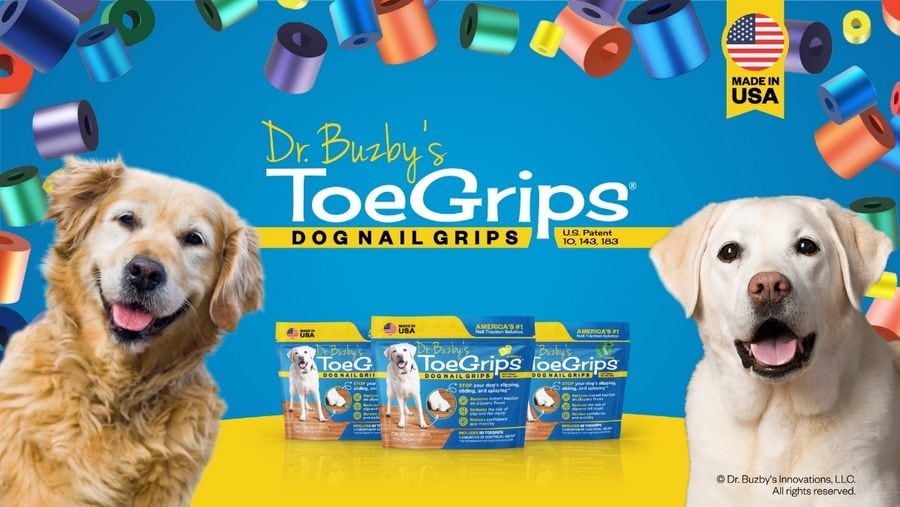
Check out the ToeGrips reviews, photos, and videos to learn how they are positively impacting pups around the world.
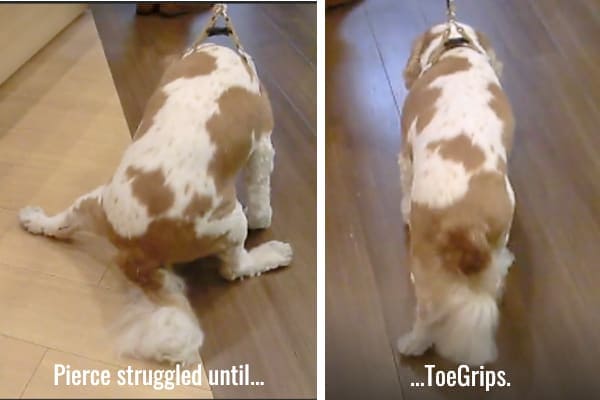
#3: Maintain proper toenail length
As I mentioned above, toenails are key to keep a dog from slipping. However, it is possible to have “too much of a good thing”. What I mean by this is that a dog with long nails can actually be prone to slipping and having a more difficult time walking.
This is because, as discussed earlier, when dogs walk normally, they flex their toes to dig their nails into the ground. However, when the toenails are long, the toes can’t flex properly. As a result, the dog will not place the feet normally and can develop an abnormal gait.
So, not only do long toenails negatively impact traction, but they also lead to abnormal muscle use and strain in the feet and legs. This can eventually make it painful for your dog to walk. And if the nails get too long, they can grow into the pads of your dog’s feet. The nail can puncture the pad, leading to wounds and possible infection. The bottom line is this—long nails are bad news all around.
Thankfully, there is a fix to this problem, and it is fairly simple—give your dog a nail trim! Nail trims are just like cutting our own fingernails. However, when cutting a dog’s nails, there are a few challenges:
- Not all dogs like their feet touched
- Some dogs are afraid of nail trims
- Accidently cutting the quick (i.e. sensitive blood supply and nerves in the nail) is painful and bloody
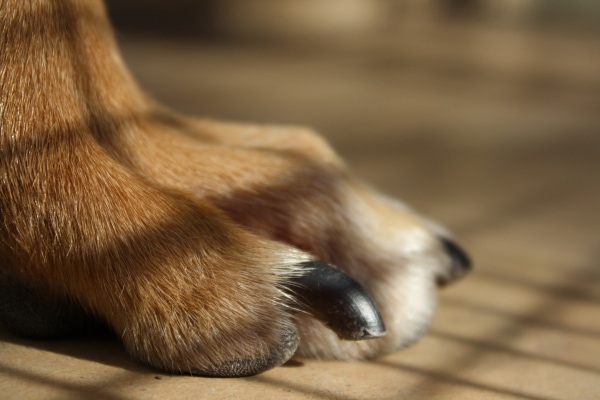
Help for doggie nail trims
I know these concerns can make nail trims very stressful for both you and your dog. But preparation (like understanding dog toenail anatomy and having the best dog nail clippers) can made a big difference. And your veterinarian can be a wonderful resource too. He or she can trim your dog’s nails and then teach you how to trim them yourself.
Additionally, I offer an online nail trimming course. In it, I discuss how to make nail trims stress free and positive so you can perform them in your own home.
Oh, and if you happen to trim your dog’s nail too short, stay calm and try not to feel too bad about it. We have all been there.
#4: Trim your pup’s paw hair
Another grooming tip that can help prevent your dog slipping on the floor is to trim excess paw hair. When a dog has very furry feet, the hair acts as a barrier between the nails, the paw pads, and the ground.
In other words, the hair causes the dog to “glide” on the wood and tile floors. It is very similar to us walking on slippery floors in socks. Traction is virtually non-existent, so of course the dog is going to slip and slide.
To prevent this, keep hair trimmed short between your dog’s toes. If you take your dog to the groomer, they should be able to help you maintain your dog’s paws. Alternatively, the veterinary team can help trim the excess hair.
#5: Use paw balms and waxes
While the toenails are important for gripping the ground when your dog walks, the paw pads also help provide traction.
When a dog walks, the paw pads come into direct contact with the ground with every step. However, if the paw pads are injured, cracked, or dry, they may not be providing the traction that your dog needs.
Some dogs are more prone to paw injuries and cracks. Predisposing factors include:
- Spending longer periods of time outdoors
- Being a senior dog
- Having allergies
- Eating poorly-balanced diets
- Suffering from hormone imbalances (like hypothyroidism in dogs)
Just like if our feet were cracked and sore, dogs with injured paw pads will be hesitant to walk on that foot. If dogs are trying to protect the cracked pads and walk differently, this also can make them more prone to slipping.
It is important then to help treat these cracks. Sometimes, paw waxes are used to promote healing. And just like lotion for our hands, paw balms can increase moisture in the paw pads. This not only will promote healing, but it also can help prevent future injury.
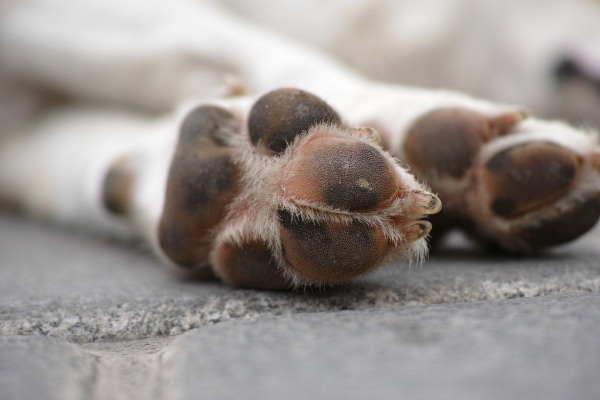
#6: Improve your dog’s joint health
Solutions two through five focused on things you can do to your dog’s body to specifically increase traction. But now we are going to switch gears for a bit and look at ways to set a dog’s body up for success on slippery floors. The first way to to this is by improving your dog’s joint health.
As a brief review, the joint is the place where two bones meet. These joints are what allow limbs to have a range of motion. In other words, they let the muscles change the position of the bones so the dog can run, walk, jump, play, etc.
Unfortunately, for many dogs, facing a joint problem at some point in their life is almost inevitable. Joints can become stiff, injured, or full of abnormal material. When this happens, it can be extremely painful and impact your dog’s ability to walk. If you or anyone you know suffers from arthritis, you know what I am talking about.
Painful joints and decreased range of motion can result in gait changes. When the dog steps on slippery floors or uneven surfaces, this abnormal gait puts them at increased risk of falling. And since these dogs are already sore, they can easily become even more painful after slipping on the floor.
The good news is that there are many joint supplements for dogs on the market that can help improve joint health, comfort, and function. The key is finding something that is scientifically supported and will actually work for your dog.
Try Encore Mobility
My all-time favorite joint supplement is Dr. Buzby’s Encore Mobility™ hip and joint supplement. It is a unique combination of two all-natural “super supplements,” green lipped mussel for dogs and New Zealand Deer Velvet for dogs. These two products work together in Encore Mobility to soothe stiff joints, improve comfort, and renew vitality.
Save 10% on Encore Mobility™ Joint Supplement for Dogs
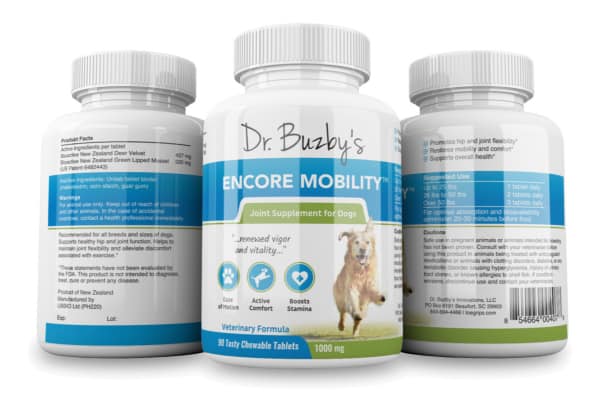
Give your dog more good days.
Use promo code HAPPY to save 10% on Encore Mobility.
I also love Encore Mobility because it helps with so much more than just joint health. In my practice, I recommend it for most of my patients, including including senior dogs, agility dogs, and dogs recovering from injuries. My clients have noticed changes in coat health, attitude, and energy in addition to better mobility and less discomfort. It is an all-around winner in my book!
#7: Consider strength training to build muscle
Following the theme of improving mobility and strength to reduce slipping, let’s move on to another component of the musculoskeletal system—the muscles.
If you have ever broken your foot, ankle, or leg, you know how this can affect the muscles you use for walking. During the healing process, you aren’t using the muscles in your leg in the same ways as before. This leads to your muscles becoming weaker. Then when your injury is healed, walking is more difficult because you have to retrain and rebuild those muscles.
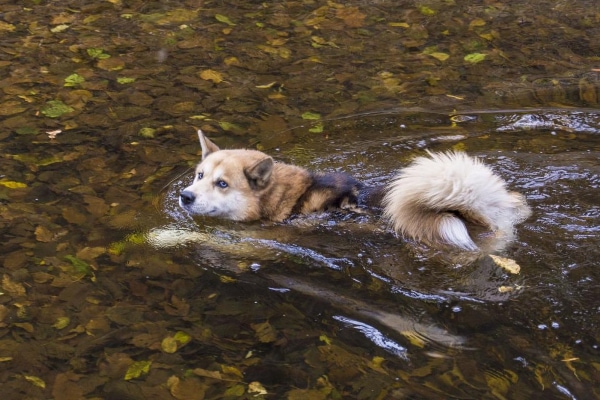
This same muscle loss occurs in injured dogs or those who are growing older. As the muscle weakens and muscle wasting occurs, dogs can lose the ability to place their legs and feet appropriately. The consequence of this is that they are prone to slipping if they are on a slick floor.
Providing strength training to your dog can help prevent this muscle loss. Plus, increasing muscle mass not only encourages your dog to walk normally, but can also help build confidence because he or she doesn’t feel as weak and shaky.
Strength training doesn’t have to be complicated or expensive to do. It can be as simple as going on walks or taking your dog swimming. The most important thing is to not overwork your dog. To ensure you are exercising your dog appropriately, talk to your veterinarian. He or she can help develop an exercise plan based on your dog’s individual ability and physical fitness.
#8: Start doing physical therapy exercises with your dog
In addition to strength training, physical therapy can be another great option for dogs who are struggling with injury or age-related musculoskeletal issues. While strength training and physical therapy may initially seem like almost the same thing, there are some key differences.
Strength training focuses on helping build muscle mass. On the other hand, physical therapy teaches the dog how to use his or her muscles and can help restore lost or reduced function.
Both strength training and physical therapy are important. And depending on the situation, one or both methods might be the right choice for a dog.
Physical therapy is often more “targeted” than strength training. Also, it often requires advice from a veterinarian or physical therapist regarding specific exercises and methods. Physical therapy can consist of:
- Improving balance
- Improving a dog’s awareness of where they are placing their feet (i.e. proprioception in dogs)
- Teaching a dog how to work muscles again
- Teaching a dog how to walk
- Helping a dog gain function back after being paralyzed
- Helping a dog learn how to walk as a three-legged dog
- Improving senior dog mobility
Because physical therapy is used in such a wide variety of situations, it employs many different exercises and tools. The plan can also change over time as your dog improves. Some different exercises or aids your dog’s physical therapist may use include:
- Underwater treadmills for dogs
- Balance balls and boards
- Obstacle courses
- Alignment exercises
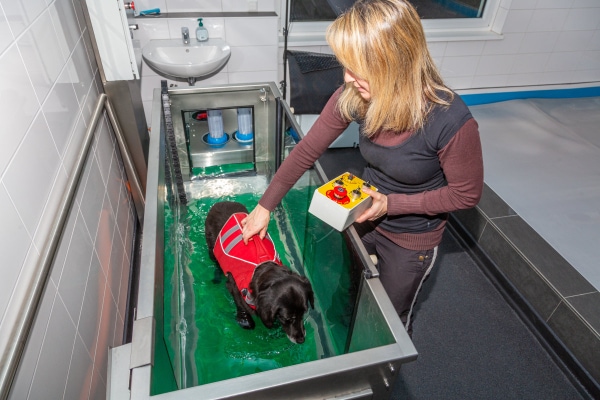
These different methods can help a dog develop the coordination, muscles, and skills needed to prevent slips and falls. As an added bonus, some exercises also stimulate the dog’s brain in ways that are helpful for counteracting canine cognitive dysfunction (i.e. age-related mental decline).
Finally, one of the best benefits of physical therapy is that many dogs also find it very fun and enjoyable.
#9: Work on weight management
Another key factor in maintaining mobility and reducing slipping is weight management.
Being overweight puts more strain and stress on a dog’s muscles and joints. The increased pressure on the joints causes them to wear down faster and lose the protective cushioning on the ends of the bone. As a result, bone rubs on bone, which is quite painful.
Dogs that are overweight also become tired easier. This makes them less active, which can lead to muscle loss.
So, as you can see, the excess weight can lead to a spiral that affects so many parts of a dog’s body. As the spiral continues, the dog has more and more difficulty with walking normally and avoiding slipping.
If you are wondering, “Is my dog overweight?” I would recommend talking to your veterinarian and learning how to find your dog’s body condition score (BCS). If you do determine that your dog would benefit from shedding some pounds, check out my tips on how to help a dog lose weight.
Finally, as an added bonus, not only can weight management help prevent your dog from falling, but it also improves your dog’s health and longevity. In fact, a 2019 study published in the Journal of Internal Medicine indicated that overweight dogs had a shorter lifespan (up to 2.5 years shorter) compared to dogs of the same breed who were a healthy body condition score. That should be some good motivation to help your dog maintain a healthy weight too.
#10: Add some rugs to your shopping cart
Now we are going to switch gears a bit and look at items you could purchase or other changes you can make in your home that may help keep a dog from slipping on the floors.
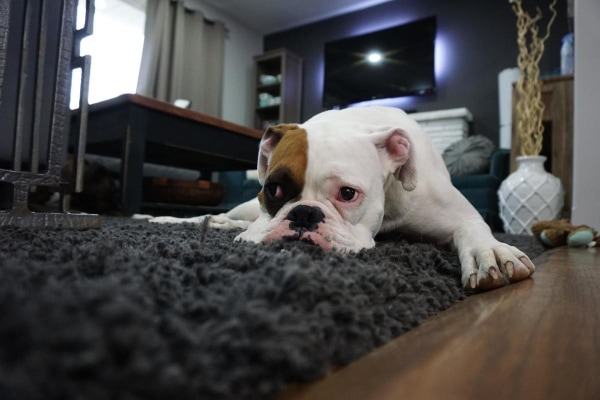
One of the most common solutions that I hear clients have tried is increasing the number of area rugs in the house. Area rugs work because they cover the slippery surface and give the dog something to gain traction on. Just like how we are more likely to slip on ice than grass, hardwood is easier to lose traction on than carpet.
If you don’t mind extra area rugs in the house, this can be a good solution to help your dog have more freedom without the fear of falling. They work well and dogs aren’t usually afraid of them. Rugs are also nice because you don’t have to teach your dog how to use them or adjust to the change.
However, non-slip rugs for dogs can pose some extra problems too.
- Cost—If you have a lot of hardwood in your house, buying enough rugs can get expensive.
- Cleaning—Parents of senior dogs or those whose pups have incontinence in dogs don’t like that they are harder to clean than hardwood or laminate.
- Isolation—Unless you have rugs in every square inch of your house, your dog may end up getting stuck on the rug “islands”. This may mean he or she can’t access the areas of the house where the family is spending time together.
- Not 100%—If a dog is standing, walking, or lying somewhere not covered by a rug, slipping is still a problem.
#11: Use a sling or harness for support
For dogs that are suffering from specific problems like paralysis or a spine or leg injury, slings and harnesses can be a wonderful solution to keep dogs from slipping on the floor.
These slings allow you as the dog parent to guide your dog and support them as they walk. By you “carrying” some of the weight in the harness, your dog does not have to put as much strain on his or her bones and joints. Also, you are in control and can ensure your dog doesn’t fall. This is especially important for dogs who are healing from an injury and need to ease back into normal activity.
Slings can also be useful when participating in physical therapy. For dogs who are re-learning how to walk properly, a harness can be used to support them while another person guides them on proper foot placement.
Two of my favorite assistive devices are the GingerLead® Support and Rehabilitation Harness, and the Help ‘Em Up® Mobility Harness. The GingerLead provides more “on-demand” support for movement while the Help ‘Em Up is a wearable harness that is perfect for dogs who need more help and support to rise and move.
Of course, the biggest downfall to slings is that they require you to be present to help your dog. So, they are not the best 24/7 solution, but they do have their place.
#12: Give your dog some wheels (i.e. a cart)
Carts are a wonderful newer option that are now available for dogs. However, they are not intended for just any dog. They are usually specific to tripawds and dogs who are paralyzed.
If you have one a dog with one of these conditions, carts can be a wonderful way to help your dog get around without your constant help. Carts provide support to the part of the body that is weaker so your dog is less likely to fall and they don’t require you to hold your dog up with a harness.
Please note that carts do have a learning curve for both dogs and their parents, and must be fitted to the dog. Unfortunately, some dogs are afraid of their carts initially and must be trained on how to walk with them. But with time and patience, carts can bring a lot of freedom to the right dog and family.
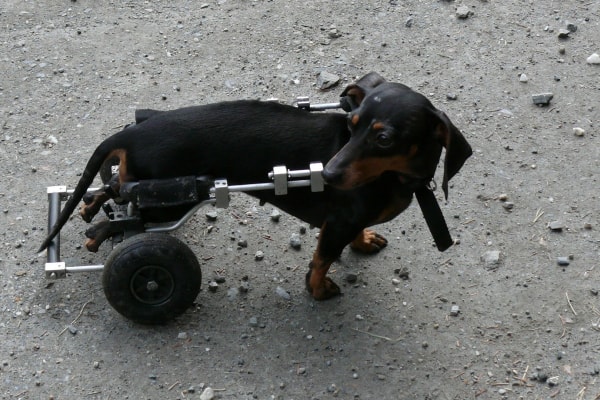
#13: Don’t succumb to the temptation to try booties or socks for slipping dogs
And finally, I want to mention a few things that I DON’T recommend doing. They are well-intentioned but may not be good for your dog or truly necessary.
In my line of work as a integrative veterinarian who focuses on senior dogs, I meet a lot of dogs whose parents are tired of seeing them be scared and fall on the floors. Every dog parent wants to do whatever they can to help their poor dog. And often the first solution they try is dog boots and socks.
I understand why this tends to be the thing that people reach for. After all, when we need better traction, we put on shoes. Why not do the same with our dogs?
However, dogs aren’t people. What works to give us a grip is actually counterproductive for them. Socks or booties actually interfere with the function of a dog’s natural traction mechanisms (i.e. their nails and paw pads).
I also don’t like anti-slip boots for traction improvement because:
- They fall off easily
- Dogs often find them irritating, especially if worn for long periods of time
- They cover the whole paw which can be hindering to the dog
- Dogs sweat through their paws. Boots prevent their paws from “breathing”
- Socks should not be worn for long periods of time
- Booties and socks can get dirty quickly
- Some dogs will eat the boots
Of course, there are times when booties can be helpful for dogs. But this is usually when their paws need protected, such as from hazardous weather conditions like cold and snow. In that case, there is one specific type of boot that I can comfortably recommend, and that is Pawz Dog Boots.
#14: Avoid baby gates if possible
Another solution I often get questions about are baby gates. While baby gates do not pose any direct risk or harm to your dog, they are not my favorite solution.
The purpose of baby gates is to keep your dog in one specific area where they won’t fall on slippery flooring. Makes sense in theory. However, this can lead to your dog feeling isolated and confined. Especially for dogs who are used to being with their parents all the time and having free roam of the house, being trapped behind a gate can be difficult and distressing.
I do understand, though, that this is going to be a solution that works well for some dogs and families. And it is definitely appropriate if it keeps your dog from dangerous situations such as falling down a flight of stairs.
#15: Don’t feel the need to redo your floors or move
While I love that I have clients who love their dog so much that they consider redoing the floor or moving for them, this is not a necessary step that you have to take. This is a very expensive and probably stressful solution. There are a lot of other things you can try before you resort to such drastic measures!
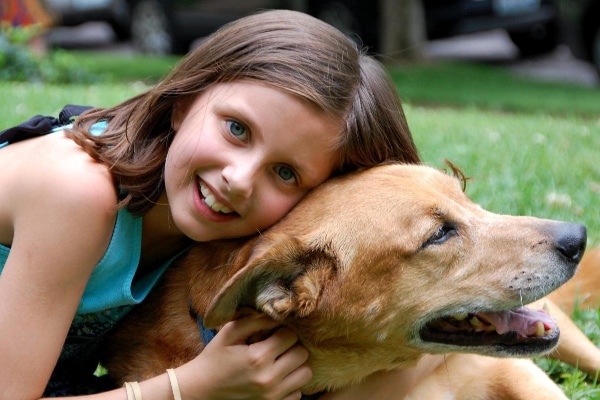
Hope for slipping dogs
My goal in sharing all these tips is to give you hope. Hope that your dog can gain traction on your slippery floors. Hope that you won’t constantly be worried about your dog falling and getting hurt. And hope that your dog doesn’t have to miss out on quality family time for fear of slipping.
Thankfully, there are many ways to keep your dog from slipping and help him or her walk with confidence again. Start with a visit to your vet to assess your dog’s weight and overall health (with special emphasis on his or her musculoskeletal and neurologic systems). Then, put some of the remaining 14 tips on this list into practice.
I want to leave you with one final thought. While I will admit that I am a bit biased since they are my signature product, ToeGrips really are the stand-out solution for slipping dogs. They are safe, easy to apply, and provide traction 24/7 no matter where your dog is or what he or she is doing. If you were only going to do one thing from this list of tips (in addition to visiting the vet of course), ToeGrips are hands-down the thing to pick.
What has worked best to keep your dog from slipping on the floor?
Please comment below to share your tips and tricks with other devoted dog parents.


Sarge, a 16 year old, 18 lb, neutered male, has osteoarthritis and possibly some concurrent neurological problems. His pain is well controlled with Librela, Adequan and Carporfen medications along with Encore Mobility and NOW Pets UC-II Advanced Joint Mobility supplements. However, Sarge has a weak rear end, difficulty standing up, and problems with his rear paws slipping on tile floors and scuffing/dragging on concrete sidewalks (not knuckling). The concrete scuffing had ground down his two inside, weight-bearing nails on both rear paws and abraded the pads so I couldn’t use Toe Grips on those nails, and using Toe Grips on the outside nails only was ineffective. I had to use traction socks for a couple months to allow pads to heal and inner nails to grow long enough for toe grips. Unfortunately, the inner nails grew back abnormally, some upside-down (curving upwards and some sideways (curving 90 degrees) so I still can’t use the Toe Grips. I’ve had the Vet Techs trim these nails way down, but they still grow back abnormally in the wrong direction. Because traction socks only last one day before getting holes, they have become too expensive to keep replacing, I’m currently trying Wagwellies rubber booties which protect his nails and pads well from scuffing/dragging, but they cause him to stumble, high-step, and have a wobbly gait due to the loss of proprioception you have mentioned. Please advise my options to help Sarge.
Hi Christopher,
I am sorry Sarge is facing so many issues with his mobility. He is very lucky to have you taking such good care of him and advocating for his health and well-being. I am glad you gave ToeGrips a try and understand why they were not able to help as intended. We do offer a no-hassle money back guarantee so our customers can try ToeGrips risk free. If you wanted to talk to our expert customer care team you can contact them at: [email protected]
They may be able to offer assistance. Other than what you have already mentioned, I do think your boy could benefit from physical therapy/rehabilitation. Also, a brace may be a good option for your pup. I generally do not recommend them for all mobility issues, but I think your boy might be a good candidate. There are so many different braces available, and I would encourage you to discuss pros and cons with a veterinary rehabilitation professional. But here is a link to Balto’s website (a company I trust) just to show you what type of device I am referring to: https://baltousa.com/collections/canine-balto-braces/products/balto-pull
Hoping you can find a way to restore Sarge’s quality of life. Best wishes to you both and keep up the good work!
I purchased the xxxl ToeGrips for our 160 pound, 6 year old Neo Mastiff who has a great deal of trouble with slipping, despite the many rugs I’ve laid everywhere. They fit snugly and I was careful to put them on exactly as instructed, so the grips would meet the floor. And they did help immediately! Unfortunately, they won’t stay on. They only stay if they are too far up on the nail I am going to try to glue them, although I hate to do that. He lost several outside,so I’ll try to make do with 15. I do wish these were more affordable, especially as he loses them so quickly. can you advise me on which paw and toe is best to leave without a grip, since we’re down to 15? Wish us luck! Thanks!
Hi Mary Jo,
I am sure our customer service team can help you with this ToeGrips dilemma! Please reach out to them by email or text.
Email: [email protected]
Text: (843) 781-6430
They can walk you through the gluing process and help troubleshoot any other issues that arise. Thank you for purchasing ToeGrips for your big boy. ♥
My 16 year old min pin could not walk on our laminate wood floors. After trying many different items from amazon (could not use rugs because she urinated on them) I finally found my solution. My whole house was a maze of tool box liners! They were easy to clean when she had mistakes. I used Clorox wipes. Towards the end of her life (euthanized last night, which brought me here to begin with) I was throwing them in the washing machine and dryer every other week.
Hope it helps if your toe grips don’t.
FYI: I googled you because I’m feeling horrible guilt about putting my baby girl, Roxy, to sleep last night. Chronic kidney failure. My heart hurts so bad! I can’t stop crying and I’m sick to my stomach. It’s horrible to say but I feel like I killed her. 😭
Dear Laura,
Thank you for being willing to share your story and experience with our readers. I hope these ideas will help someone else in a similar situation. My heart goes out to you with your recent loss of Roxy. You made a loving choice to give her peace and rest from her struggles. What a selfless and loving act to allow your own heart to break so Roxy could be whole again. I have no doubt your sweet girl knew how much she was loved. I will attach links to other articles that I hope will offer your heart some comfort. I know most of these deal with deciding when to say goodbye, but they have good comments from other readers as well. Praying with time your heart will heal. May Roxy’s memory be a blessing.
1. Grieving the Loss of a Dog After Euthanasia (& Finding Peace)
2. Dog Kidney Failure: When to Euthanize Your Dear Dog
3. Preparing for Your Dog’s Euthanasia: 10 Thoughts for Peace
My dog recently has been going around in circles on her tail area, not in the house but when we go walking, She stops frequently during our walks to rub, her tail end and tries to nibble on her tail near the rectum. She has also started biting her toe nails. Love my dog dearly, am on fixed income bur worry about my dog’s health. She was a service dog when I adopted her, her job was to jump on the chest of her owner and lick the owner’s face as if to keep them conscious. She prefers to be indoors near me. I have mostly hard surface floors except in the living room where I have a rug, but she prefers my bed.
Hi L Jolliffe,
I understand your concern with these strange symptoms your dog is displaying. Since I haven’t examined her myself, I can’t make specific conclusions or recommendations. From what you are describing, I am suspicious about several things. Rubbing and biting near the base of the tail or rectum could be signs of fleas (even if you aren’t seeing any) or anal gland issues. Dogs that bite their toenails can be suffering from allergies, an infection near the nail beds, or discomfort from nails that are too long. Your best bet is to let your veterinarian examine your pup and give you some answers. There may be a simple fix that could really improve your dog’s quality of life.
FANTASTIC & WONDERFUL INFORMATIVE. VERY HELPFUL ARTICLE!! YOGA MATS 🧘♀️ WHO WOULD HAVE THOUGHT!!
I HAVE 2 SENIOR WIENERS 17 1/2 & 15 1/2 FATHER & SON WITH BOTH HAVING ISSUES WITH DIFFICULTY ON OUR LINOLEUM & LAMINATE KITCHEN FLOORS.
BOTH MOVE MUCH SLOWER & I KNOW THEY MUST SUFFER FROM ARTHRITIS & TINY HAD A DOUBLE CERVICAL LAMINECTOMY ( IVDD) 7 YEARS AGO & WAS DOING GREAT UP UNTIL THIS YEAR HAVING ISSUES WITH HIS HIND LEGS & GAIT STIFFNESS & LIMPING RECENTLY TAKING A 1
TAPERING DOSE OF PREDNISONE & GABAPENTIN & NSAIDS. UNFORTUNATELY WITHIN ABOUT 4 DAYS OF HIS LAST PREDNISONE HE IS HAVING THE SAME ISSUES AGAIN EVEN TAKING JUST THE GABA & NSAIDS SO WILL B DISCUSSING WITH OUT VET AGAIN. MY TINY IS ALSO 18.5 LBS WHICH IS TOO MUCH FOR A WEINER DOG.
HE HAS ALWAYS LOVED TO EAT BUT MUCH LESS ACTIVE SO HAS UNFORTUNATELY ADDED TO HIS CURRENT ISSUES 😕
I WILL TAKE ALL YOUR ADVICE DR. BUZBY 2 HELP MY OLDIES BUT DEAREST GOODIES FEEL BETTER ❤
THANK U SO MUCH
Hi Pam,
Thank you so much for leaving the positive feedback about the article. I am glad you found it helpful and informative! Give both of your sweet boys a hug for me. ♥
Thank you for this very helpful article. It was extremely informative. Much appreciated. I’m certain that it will improve the lives of many dogs – especially seniors!
In addition to many of the great tips here, we bought a bunch of yoga mats and put them in Harley’s favorite places to be around the house. They’re inexpensive, easy to clean, and nice on our feet too. Thanks for the great article!
Hi Anne,
Yoga mats are a great idea! Thank you for sharing this tip with our readers. Give Harley a hug for me. ♥
We’ve done the same for our 16 year old dachshund, Otto. The yoga mats work much better for him than area rugs (they’re also easily washable). Between the yoga mats, keeping his toenails trimmed and the hair between his paws trimmed, Otto rarely slips in the house anymore.